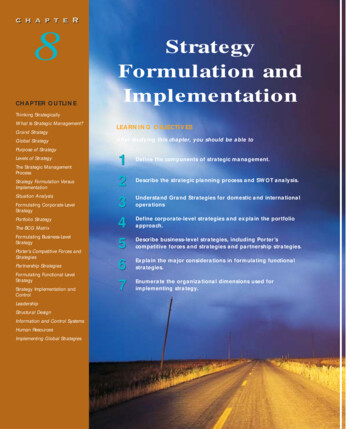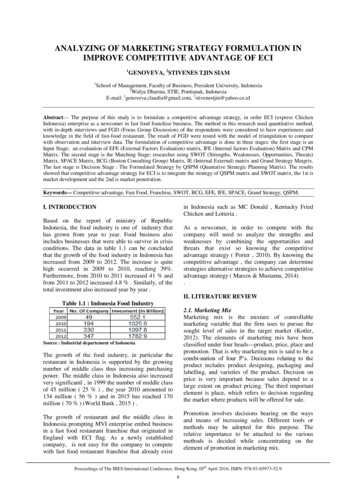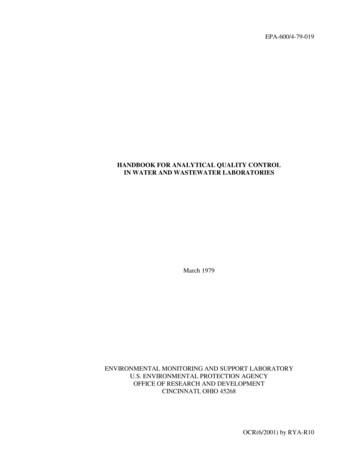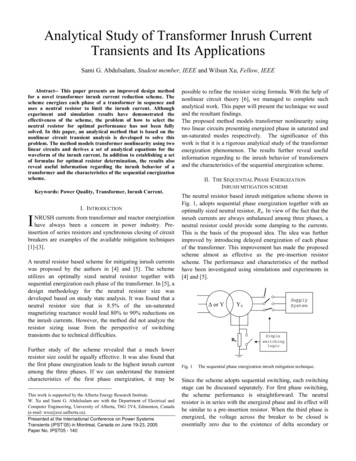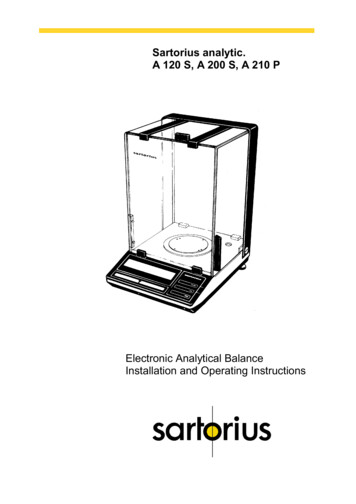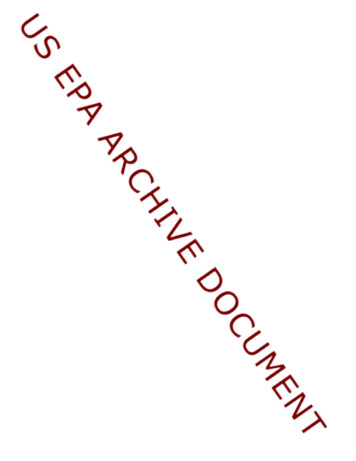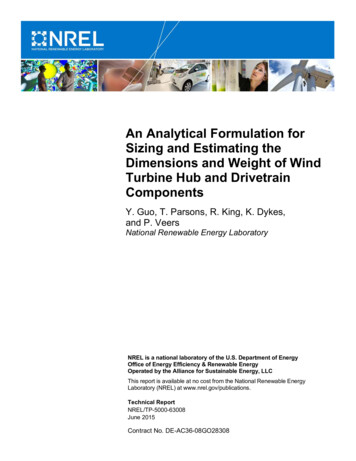
Transcription
An Analytical Formulation forSizing and Estimating theDimensions and Weight of WindTurbine Hub and DrivetrainComponentsY. Guo, T. Parsons, R. King, K. Dykes,and P. VeersNational Renewable Energy LaboratoryNREL is a national laboratory of the U.S. Department of EnergyOffice of Energy Efficiency & Renewable EnergyOperated by the Alliance for Sustainable Energy, LLCThis report is available at no cost from the National Renewable EnergyLaboratory (NREL) at www.nrel.gov/publications.Technical ReportNREL/TP-5000-63008June 2015Contract No. DE-AC36-08GO28308
An Analytical Formulation forSizing and Estimating theDimensions and Weight ofWind Turbine Hub andDrivetrain ComponentsY. Guo, T. Parsons, R. King, K. Dykes,and P. VeersNational Renewable Energy LaboratoryPrepared under Task No. WE14.3G01NREL is a national laboratory of the U.S. Department of EnergyOffice of Energy Efficiency & Renewable EnergyOperated by the Alliance for Sustainable Energy, LLCThis report is available at no cost from the National Renewable EnergyLaboratory (NREL) at www.nrel.gov/publications.National Renewable Energy Laboratory15013 Denver West ParkwayGolden, CO 80401303-275-3000 www.nrel.govTechnical ReportNREL/TP-5000-63008June 2015Contract No. DE-AC36-08GO28308
NOTICEThis report was prepared as an account of work sponsored by an agency of the United States government.Neither the United States government nor any agency thereof, nor any of their employees, makes any warranty,express or implied, or assumes any legal liability or responsibility for the accuracy, completeness, or usefulness ofany information, apparatus, product, or process disclosed, or represents that its use would not infringe privatelyowned rights. Reference herein to any specific commercial product, process, or service by trade name,trademark, manufacturer, or otherwise does not necessarily constitute or imply its endorsement, recommendation,or favoring by the United States government or any agency thereof. The views and opinions of authorsexpressed herein do not necessarily state or reflect those of the United States government or any agency thereof.This report is available at no cost from the National Renewable EnergyLaboratory (NREL) at www.nrel.gov/publications.Available electronically at SciTech Connect http:/www.osti.gov/scitechAvailable for a processing fee to U.S. Department of Energyand its contractors, in paper, from:U.S. Department of EnergyOffice of Scientific and Technical InformationP.O. Box 62Oak Ridge, TN 37831-0062OSTI http://www.osti.govPhone: 865.576.8401Fax: 865.576.5728Email: reports@osti.govAvailable for sale to the public, in paper, from:U.S. Department of CommerceNational Technical Information Service5301 Shawnee RoadAlexandra, VA 22312NTIS http://www.ntis.govPhone: 800.553.6847 or 703.605.6000Fax: 703.605.6900Email: orders@ntis.govCover Photos by Dennis Schroeder: (left to right) NREL 26173, NREL 18302, NREL 19758, NREL 29642, NREL 19795.NREL prints on paper that contains recycled content.
AbstractThis report summarizes the theory, verification, and validation of a new sizing tool for wind turbine drivetrain com ponents, the Drivetrain Systems Engineering (DriveSE) tool. DriveSE calculates the dimensions and mass propertiesof the hub, main shaft, main bearing(s), gearbox, bedplate, transformer if up-tower, and yaw system. The level of fi delity for each component varies depending on whether semiempirical parametric or physics-based models are used.The physics-based models have internal iteration schemes based on system constraints and design criteria. Everymodel is validated against available industry data or finite-element analysis. The verification and validation resultsshow that the models reasonably capture primary drivers for the sizing and design of major drivetrain components.iiiThis report is available at no cost from the National Renewable Energy Laboratory at www.nrel.gov/publications
List of FFWFΔ ()HIItkKAGKrKshKvkwKγbKγ pLMeaningAmerican Gear Manufacturer’s Associationcompact-aligning roller bearingcenter of masscenter of gravitycylindrical roller bearingDrivetrain Systems arallel-parallelfinite-element analysisGearbox Reliability CollaborativeInternational Electrotechnical CommissionInternational Organization for Standardizationhigh-speed shaftsingle-row deep-groove radial ball bearingrotor-nacelle assemblyspherical roller bearingsingle-row tapered roller bearingdouble-row tapered roller bearingMeaningWeibull scale parameterBlade numberNumber of planet gearsCoefficient of liftCenter of massDiameterGear diameterDamage caused by fatigueYoung’s modulusFrequencyForce or loadFace widthStochastic load range at given load countHeightSecond moment of areaTurbulence intensity factorSafety factorApplication factorScaling factorShaft factorDynamic factorWeibull shape parameterLoad-sharing factor between rowsLoad-sharing factor among planetsLengthContinued on next pageivThis report is available at no cost from the National Renewable Energy Laboratory at www.nrel.gov/publications
– continued from previous MSySmSUTtthTTDTLUvVVmin mentNumber of stress cycles, number of cycles to failure at given amplitudeMaximum number of load cycles experienced by componentsSpeedDiametral pitchPowerAerodynamic line-loadInput torque to the main shaftInput torque to the pinionRadiusFatigue strengthStress range caused by specified force (fatigue)Stress range caused by specified moment (fatigue)Yielding strengthFatigue failure point at 103 cyclesUltimate material strengthTimeThicknessTorqueTip deflectionTurbine lifeSpeed ratioTransverse deflectionVolumeCut-in, cut-out windspeedsNominal wind speedWeightGear pair weightTangential driving forceTip-speed ratioDrivetrain efficiencyBedplate tilt angleWeight per unit lengthNormal stressShear stressvon Mises stressMaximum principal stressAlternating stressMean stressEffective alternating stress at n bearing–main shaft center of massAxialBladeBending stress rangeMain bearing–gearbox trunnionCharacteristicEquivalent stress rangeMain shaft flangeBearing-gear couplingContinued on next pagevThis report is available at no cost from the National Renewable Energy Laboratory at www.nrel.gov/publications
NomenclatureGBgbxgcGEgenhbhsmb1, mb2mbmsms, inormprrarbRNAsrgtTFTW– continued from previous pageMeaningGearboxGearboxGear couplingGeneratorGeneratorHubHigh-speed shaft/couplingUpwind and downwind main bearing for four-point suspensionMain bearing for three-point suspensionMain shaftInner main shaftNormal stress rangePlanetRotorRadialRotor–main bearingRotor–nacelle iptMeaningx, y, zde, mean, ult, maxstCoordinatesLoad type (deterministic, mean, ultimate, maximum)stochasticviThis report is available at no cost from the National Renewable Energy Laboratory at www.nrel.gov/publications
Table of Contents1Introduction . . . . . . . . . . . . . . . . . . . . . . . . . . . . . . . . . . . . . . . . . . . . . . . . . . . . . . . . .2Drivetrain Model Description . . . . . . . . . . . . . . . .2.1 Hub . . . . . . . . . . . . . . . . . . . . . . . . . . . .2.1.1Mass Property Calculations . . . . . . . . . .2.2 Main Shaft . . . . . . . . . . . . . . . . . . . . . . . .2.2.1Shaft Load Analysis . . . . . . . . . . . . . .2.2.1.1Three-Point Suspension Drivetrain .2.2.1.2Four-Point Suspension Drivetrain .2.2.2Shaft Dimension Determination . . . . . . . .2.2.3Mass Property Calculations . . . . . . . . . .2.3 Main Bearings . . . . . . . . . . . . . . . . . . . . . .2.4 Gearbox . . . . . . . . . . . . . . . . . . . . . . . . .2.4.1Sizing of a Single External Gear . . . . . . . .2.4.2Sizing of an External Gear Pair . . . . . . . .2.4.3Sizing of a Planetary Gear Stage . . . . . . . .2.4.4Gearbox Total Weight . . . . . . . . . . . . .2.4.5Gearbox Speed Ratio Optimization . . . . . .2.4.6Mass Property Calculations . . . . . . . . . .2.5 Yaw System . . . . . . . . . . . . . . . . . . . . . . .2.5.1Mass Property Calculations . . . . . . . . . .2.6 Bedplate . . . . . . . . . . . . . . . . . . . . . . . . .2.6.1Mass Property Analysis . . . . . . . . . . . .2.7 Additional Nacelle Components . . . . . . . . . . . . .2.7.1Mass Property Calculations . . . . . . . . . .355566891011131314151515171819192021213Model Verification Against Higher Fidelity Models . . . . . . . . . . . . . . . . . . . . . . . . . . . . . . . . . . .3.1 Main Shaft Analysis . . . . . . . . . . . . . . . . . . . . . . . . . . . . . . . . . . . . . . . . . . . . . . . . . .3.2 Bedplate Analysis . . . . . . . . . . . . . . . . . . . . . . . . . . . . . . . . . . . . . . . . . . . . . . . . . . .2323244Model Validation and Results . . . .4.1 Hub . . . . . . . . . . . . . . . .4.2 Main Shaft and Bearings . . . . .4.3 Gearbox Stage Ratio and Weight4.4 Bedplate . . . . . . . . . . . . .4.5 Nacelle Mass . . . . . . . . . . .2626272829305Conclusions . . . . . . . . . . . . . . . . . . . . . . . . . . . . . . . . . . . . . . . . . . . . . . . . . . . . . . . . .32References . . . . . . . . . . . . . . . . . . . . . . . . . . . . . . . . . . . . . . . . . . . . . . . . . . . . . . . . . . . .336Appendix A: Reference Model Inputs . . . . . . . . . . . . . . . . . . . . . . . . . . . . . . . . . . . . . . . . . . .357Appendix B: Shaft and Bearing Design with Parameterized Fatigue Spectrum (Optional) . . . . . . . . . . . . . .388Appendix C: Parameterized Fatigue Loads Definition . . . . . . . . . . . . . . . . . . . . . . . . . . . . . . . . . .459Appendix D: Simplified Four-Point Suspension Main Shaft Model (Optional) . . . . . . . . . . . . . . . . . . . . .49.viiThis report is available at no cost from the National Renewable Energy Laboratory at www.nrel.gov/publications1
10 Appendix E: Additional Bearing Load Rating and Mass Curves Used in DriveSE . . . . . . . . . . . . . . . . . .51List of FiguresFigure 1.DriveSE calculation flowchart . . . . . . . . . . . . . . . . . . . . . . . . . . . . . . . . . . . . . . . . . . .3Figure 2.Force diagram of a main shaft in a three-point suspension drivetrain . . . . . . . . . . . . . . . . . . . . . . .6Figure 3.Force diagram of a main shaft in a four-point suspension drivetrain . . . . . . . . . . . . . . . . . . . . . . .8Figure 4.Flowchart of main shaft/bearing sizing model . . . . . . . . . . . . . . . . . . . . . . . . . . . . . . . . . . .10Figure 5.Dynamic load ratings for CARBs . . . . . . . . . . . . . . . . . . . . . . . . . . . . . . . . . . . . . . . . .11Figure 6.Dynamic load ratings for CARBs after load distinction . . . . . . . . . . . . . . . . . . . . . . . . . . . . . .12Figure 7.CARB mass and facewidth interpolation . . . . . . . . . . . . . . . . . . . . . . . . . . . . . . . . . . . . .12Figure 8.Flowchart of the gearbox sizing tool . . . . . . . . . . . . . . . . . . . . . . . . . . . . . . . . . . . . . . . .14Figure 9.Flowchart of the gearbox iteration process for determining the stage ratios . . . . . . . . . . . . . . . . . . .18Figure 10. (A) Loads and constraints applied to the 750-kW LSS; (B) the mesh used in the analysis; and the plots of (C)von Mises stress, (D) shear stress, and (E) deformation . . . . . . . . . . . . . . . . . . . . . . . . . . . . . . . . . .23Figure 11. DriveSE basic I-beam assembly with large front cast iron beam and long rear steel piece. Note the split linesacross the top faces of I-beams at the component locations. . . . . . . . . . . . . . . . . . . . . . . . . . . . . . . .25Figure 12.Industry trend and model results: hub mass compared to turbine nameplate rating . . . . . . . . . . . . . . . .26Figure 13.Industry trend and model results: main shaft mass compared to turbine rating . . . . . . . . . . . . . . . . . .28Figure 14.Industry trend and model results: gearbox weight compared to rated torque . . . . . . . . . . . . . . . . . . .29Figure 15.Industry trend and model results: bedplate mass compared to rotor diameter . . . . . . . . . . . . . . . . . . .30Figure 16.Industry trend and model results: nacelle mass compared to rotor diameter . . . . . . . . . . . . . . . . . . .30Figure 17.Flowchart of main shaft and bearing fatigue sizing tool . . . . . . . . . . . . . . . . . . . . . . . . . . . . . .39Figure 18.Force and moment spectra defined by DS472 using inputs from a 750-kW rotor . . . . . . . . . . . . . . . . .47Figure 19.Dynamic load ratings for SRBs . . . . . . . . . . . . . . . . . . . . . . . . . . . . . . . . . . . . . . . . . .51Figure 20.SRB mass and facewidth interpolation . . . . . . . . . . . . . . . . . . . . . . . . . . . . . . . . . . . . . .51Figure 21.Dynamic load ratings for CRBs . . . . . . . . . . . . . . . . . . . . . . . . . . . . . . . . . . . . . . . . . .52Figure 22.CRB mass and facewidth interpolation . . . . . . . . . . . . . . . . . . . . . . . . . . . . . . . . . . . . . .52Figure 23.Dynamic load ratings for TRBs1 . . . . . . . . . . . . . . . . . . . . . . . . . . . . . . . . . . . . . . . . .53Figure 24.TRB1 mass and facewidth interpolation . . . . . . . . . . . . . . . . . . . . . . . . . . . . . . . . . . . . . .53Figure 25.Dynamic load ratings for TRBs2 . . . . . . . . . . . . . . . . . . . . . . . . . . . . . . . . . . . . . . . . .54Figure 26.TRB2 mass and facewidth interpolation . . . . . . . . . . . . . . . . . . . . . . . . . . . . . . . . . . . . . .54Figure 27.Dynamic load ratings for RBs . . . . . . . . . . . . . . . . . . . . . . . . . . . . . . . . . . . . . . . . . . .55Figure 28.RB mass and facewidth interpolation . . . . . . . . . . . . . . . . . . . . . . . . . . . . . . . . . . . . . . .55viiiThis report is available at no cost from the National Renewable Energy Laboratory at www.nrel.gov/publications
List of TablesTable 1.Required Parameters for DriveSE Component Sizing . . . . . . . . . . . . . . . . . . . . . . . . . . . . . . .4Table 2.Maximum Ranges for Slopes and Transverse Deflections (Shigley et al. 2003) . . . . . . . . . . . . . . . . . .6Table 3.I-Beam Properties . . . . . . . . . . . . . . . . . . . . . . . . . . . . . . . . . . . . . . . . . . . . . . . . . .20Table 4.Loads Applied to Main Shaft Components, in Global Nacelle Coordinate System . . . . . . . . . . . . . . . .24Table 5.Resulting Maximum Stress Concentrations and Deflections at the Location of the Bearings . . . . . . . . . . .24Table 6.Bending Stress and Tip Deflection Compared for Rear Beams. . . . . . . . . . . . . . . . . . . . . . . . . .24Table 7.Maximum Bending Stress and Tip Deflection Compared for Front Beams . . . . . . . . . . . . . . . . . . . .25Table 8.Comparison of Hub Model Outputs to FE Model Masses . . . . . . . . . . . . . . . . . . . . . . . . . . . . .26Table 9.Comparison of Nonfatigue Main Shaft Model Output and Solid Mass Dimensions . . . . . . . . . . . . . . . .27Table 10.Comparison of Fatigue Main Shaft Model Output and FE Model Dimensions . . . . . . . . . . . . . . . . . .27Table 11.Comparison of Fatigue and Nonfatigue Models to the FE Model Mass . . . . . . . . . . . . . . . . . . . . . .27Table 12.Gearbox Speed Ratio per Stage of the GRC 750-kW Gearbox. . . . . . . . . . . . . . . . . . . . . . . . . .28Table 13.Comparison of Bedplate Model Outputs to FE Model Masses . . . . . . . . . . . . . . . . . . . . . . . . . . .29Table 14.Effects of Transformer Location on Bedplate Dimensions and Mass for the 1.5-MW Turbine . . . . . . . . . .29Table 15.750-kW Reference Inputs . . . . . . . . . . . . . . . . . . . . . . . . . . . . . . . . . . . . . . . . . . . . . .35Table 16.750-kW Reference Fatigue Inputs . . . . . . . . . . . . . . . . . . . . . . . . . . . . . . . . . . . . . . . . .35Table 17.1.5-MW Reference Inputs . . . . . . . . . . . . . . . . . . . . . . . . . . . . . . . . . . . . . . . . . . . . . .36Table 18.1.5-MW Reference Fatigue Inputs . . . . . . . . . . . . . . . . . . . . . . . . . . . . . . . . . . . . . . . . .36Table 19.5-MW Reference Inputs . . . . . . . . . . . . . . . . . . . . . . . . . . . . . . . . . . . . . . . . . . . . . . .37Table 20.5-MW Reference Fatigue Inputs . . . . . . . . . . . . . . . . . . . . . . . . . . . . . . . . . . . . . . . . . .37Table 21.Additional Inputs Required for Parameterized Fatigue Analysis . . . . . . . . . . . . . . . . . . . . . . . . . .38Table 22.Bearing Calculation Factors Used by Bearing Type . . . . . . . . . . . . . . . . . . . . . . . . . . . . . . . .44Table 23.Description of Three Stress Sources Considered in the Main Shaft Fatigue Analysis . . . . . . . . . . . . . . .45Table 24.Relationship Between IEC Class and Turbulence Intensity Factor . . . . . . . . . . . . . . . . . . . . . . . . .47ixThis report is available at no cost from the National Renewable Energy Laboratory at www.nrel.gov/publications
1IntroductionWind turbine drivetrains serve the fundamental role of converting the aerodynamic torque of a rotor into electrical power thatcan be fed to the connecting grid. They also serve as the load path for transferring all of the nontorque loads from the rotor to thetower, which then transfers those loads to the ground. Accordingly, the drivetrain design affects and is affected by the rest of thewind turbine design.Typical design practice for a wind turbine considers constraints from the drivetrain on the rotor and tower design and vice versa.However, improvements to overall wind turbine system design can be obtained by an integrated approach that considers thesimultaneous and integrated design of the rotor, drivetrain, and tower (Ning and Dykes 2014). There are important trade-offs inthe design of these subsystems that affect each other and if not considered together, the overall system cost can be higher. Thiswas recently demonstrated in a study of the effect of tip-speed constraints on system design and cost in which an improved rotordesign for lower weight resulted in large aerodynamics loads on the drivetrain that resulted in a net increase in system cost (Dykeset al. 2014a). Allowing system cost and performance objectives to dictate the design of the wind turbine subsystems will result ina truly optimal overall wind turbine design.To enable this system-level optimization, physics-based models of all major system components are required to explicitly capturethe trade-offs between the design of different components. A previously developed physical sizing model for the drivetrain,known as the Sunderland model, was established by the University of Sunderland in the late 1990s (Harrison and Jenkins 1993).The Sunderland model used semiempirical formulations to calculate the masses of major wind turbine components. Theseformulations were derived from a limited industry database that does not represent today’s fleet. Moreover, the Sunderlandmodel cannot be used for design optimiza
Dimensions and Weight of Wind Turbine Hub and Drivetrain Components Y. Guo, T. Parsons, R. King, K. Dykes, and P. Veers National Renewable Energy Laboratory Technical Report NREL/TP-5000-63008 . File Size: 1MB



